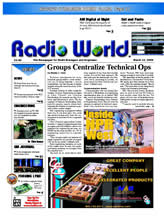
 |
|
|||||||||
|
|
 |
||||||||
 |
Summer Storms Take Their Toll by Mark Persons |
Radio World Article March 12, 2003 |
|
The
weather these past two summers has had devastating effects on my clients in
Minnesota. On June 13, 2001, a
tornado brushed the south side of Brainerd, MN.
It took down a 180 foot tower, which is one of three towers in the KLIZ-AM
night antenna system. KLIZ, a part
of Kommerstadt Broadcasting, runs 5 KW day non-directional and 5000 watts night
directional on 1380 KHz. The
falling tower clipped a guy line on a 380 foot tower in the same array.
This line was second from the top. The
tower had a bow in it until a tower crew could arrive.
It took a brave climber to snag the end of the broken guy cable so that
it could be connected to, reattached, and tensioned correctly.
Two of the antenna coupling network buildings were tipped over as well.
The
station operated under an STA (Special Temporary Authorization) with � of
normal power on the night non-directional until a new tower could be put up and
the directional array adjusted. This
proved to be more difficult than it sounded originally.
Since there was no documentation on the concrete base pier that the
original 180 foot tower stood on, the entire �tower system� had to be
engineered from the ground up for that tower.
That meant the original concrete pier had to be dug up and disposed of
before new concrete could be poured for the replacement base pier.
New guy line anchors were poured as well even though the original anchors
looked just fine. The ground system
had to be rebuilt around the base of the tower because of the construction
damage. After it was all said and
done, the new base pier was smaller than the original.
The station would not have been able to insure the tower unless this was
all done. Ah�the miracles of the
world we live in.
In
the summer of 2002, there were lightning strikes at two of the facilities that I
take care of. They were 30 miles
apart and one month apart in time. In
each case, there was major damage to the FM antennas and the transmission lines
that feed them. Each of these
$40,000 repairs involved removing the antennas and transmission lines from the
tower. Ken Martin (W9MR) of
Electronic Research, Incorporated did an excellent job sending the parts I
needed via next day shipments. Andrew
provided new 3 inch Heliax cable that came by truck.
This gave me, and others, time to work on the damaged antenna parts so
that a single one-day visit by the tower crew would finish the repair.
The
time to make repairs took a week or more in both cases.
To keep the stations on the air, I retuned a single bay circularly
polarized low power FM antenna and fed it with RG-8A/U cable.
At one station, the antenna was at 200 feet and was fed with 300 watts of
power from the transmitter IPA stage. The
coverage was about 15 miles in all directions.
The other one was at about 300 feet and was driven by 400 watts of power.
The coverage there was about 20 miles.
In both cases, the building penetration was not good, but it was better
than nothing. Mark Persons, W0MH, is certified by the Society of Broadcast Engineers as a Professional Broadcast Engineer with more than 30 years experience. He has written numerous articles for Radio World over the years. His Web site is www.mwpersons.com From the Radio World March 12, 2003 issue http://www.rwonline.com |
|
Questions? Email Mark Persons: teki@mwpersons.com |
|
.